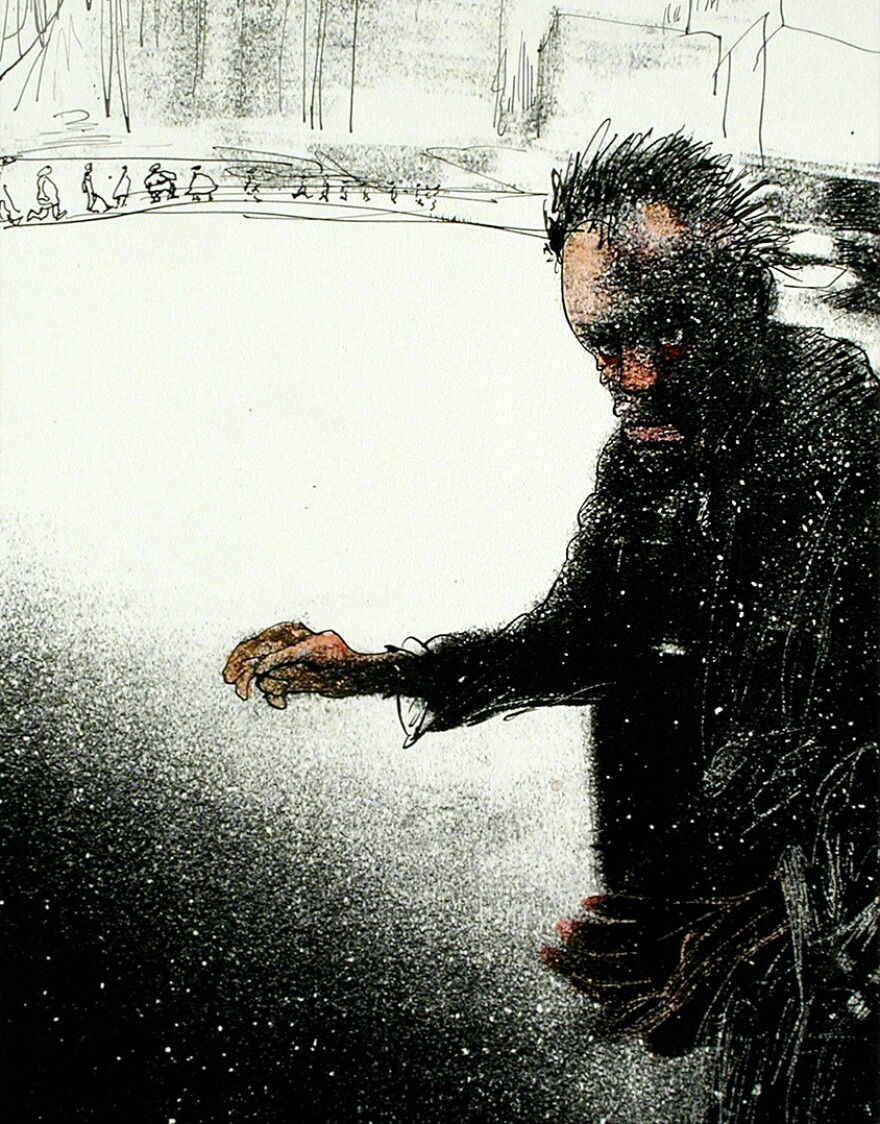Every morning, British illustrator Ralph Steadman wakes up in his country estate in rural England and attacks a piece of paper, hurling ink, blowing paint through a straw and scratching away layers to reveal lines and forms that surprise even him.

Steadman is known, in part, for his work with writer Hunter S. Thompson, a collaboration that would come to be known as "gonzo journalism," where the tale-teller becomes the tale. Beginning in 1970, the duo produced books, including Fear and Loathing in Las Vegas, and several articles for Rolling Stoneand other magazines. Thompson killed himself in 2005, but at 76, Steadman continues to work; and his ink-splattered, anarchic drawings, paintings and caricatures continue to inspire artists and musicians on both sides of the Atlantic.
Now, For No Good Reason, a new documentary that's been 15 years in the making, takes a close and personal look at Steadman's life, rise to prominence and irreverent approach to art.
Case in point: One scene in the film shows Steadman and beat writer William S. Burroughs using Steadman's drawings for target practice. It's not so much "creative destruction" as "destructive creativity." The film's director, Charlie Paul, agrees.
"He believes that by taking it to a point of no return at the very beginning, he has nothing to lose," Paul says.
The Right 'Venom' For Professional Chemistry
Hunter S. Thompson's presence permeates For No Good Reason. The film's recurring telephone ring marks how most of Thompson and Steadman's collaborative jaunts began — with a call from the writer. Then there's the title, which was pulled from something Thompson said whenever Steadman asked why they were going on a particular errand, chase or quest: "No good reason at all, Ralph."

In the film, Rolling Stone's co-founder Jann Wenner explains why he felt Steadman's art illustrated Thompson's caustic, stream-of-altered-consciousness reportage better than any photograph could.
"The thing about Ralph's work — it was just the energy, the anger, the venom that was just spewed out," he says. "And that's what I loved."
Steadman says he could keep up with Thompson's drinking, but never had much use for the drugs. Thompson never met a substance — or politician — he couldn't abuse in pursuit of his brand of journalism, and his relationship with Steadman was difficult. Still, Thompson's suicide hit Steadman hard.
The actor Johnny Depp serves as a guide in the film. Depp, who was a friend of both men, starred in the movie based on Thompson's Fear and Loathing in Las Vegas. In For No Good Reason, both Depp and Steadman try to make sense of Thompson's suicide.
"The way I came to terms with it was that this is a man who dictated the way he was going to live his life," Depp says in the film. "He was most certainly going to dictate the way he left."
In Search Of Someone To Fear And Loathe
The press launch for For No Good Reason was held in an enclosed, jungle-themed courtyard — complete with a rushing stream and the occasional bird squawk issuing from unseen speakers — at London's Barbican Center.
Producer Lucy Paul says even the youngest, hottest musicians instantly signed on when they heard the film was about Steadman.
"Somehow, Ralph reaches the whole, kind of, creative world, on all spectrums," she says.
In person, Steadman has twinkling eyes and a kindly manner — it seems that all his rage is channeled through his art. The illustrator also contributed to Thompson's Fear and Loathing: On the Campaign Trail, about the 1972 U.S. election. He shakes his head regretfully at the lack of grist for the satirical mill in the 2012 race.
"The problem is there are no Nixons around at the moment," Steadman says. "That's what we need — we need a real good Nixon."
Under Steadman's pen, then-presidential candidate Richard Nixon leans over a podium, his nose morphing into a vulpine snout. Steadman longs for a contemporary figure that would inspire, well, fear and loathing, "to give something for other people to get their teeth into," he says, "to really ... loathe him, to become themselves more effective as opposition leaders."
Today he says he still approaches every blank sheet of paper with no expectations, and with the same blazing desire that first drew him to cartooning five decades ago. He talks about wanting to change the world.
"And I think I have changed the world, because you know what? It's worse now than it was when I started!" he says, laughing.
Copyright 2020 NPR. To see more, visit https://www.npr.org. 9(MDA1MjI2NzUxMDEyNzQyMTY5MjQ2YzkwNA004))


